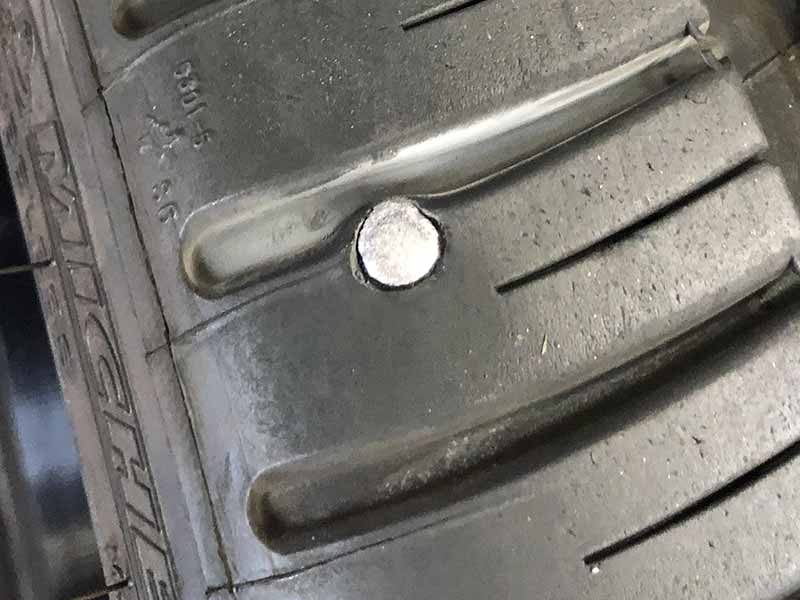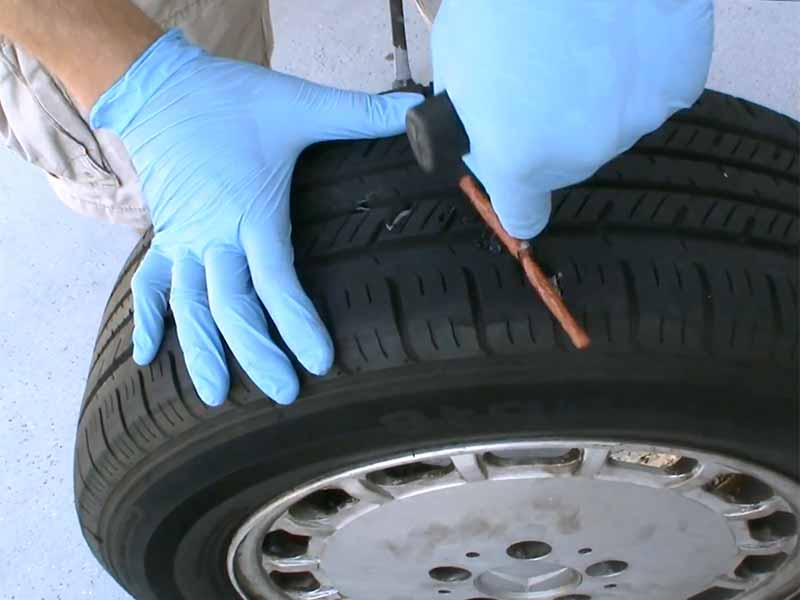Flat tire repair is often performed with a plug or patch. Both tire plugs and tire patches are durable tire repair methods, but which is best, and when should you use one over the other?
Tire Plug Vs Patch
A tire plug is a small piece of rubber inserted into a tire puncture to seal the hole and allow it to be re-inflated and be used to continue until you can have the puncture professionally inspected and repaired.
A tire patch is a larger piece of rubber or other material applied to the inside of a tire to cover a larger hole or area of damage. Patches are more durable and considered a more permanent fix.
Both are used to repair a punctured tire, but a patch is typically used for larger or more severe punctures, while a plug is used for smaller or less severe ones.
The patch and plug are excellent tire repairs when properly installed and used for their intended purpose. But what are all the important differences between these two flat tire repair methods?
Let’s take a closer look.
What Is A Tire Plug?
Tire plugs typically come in a kit that includes a plug insertion tool and a reaming tool. The insertion tool is used to insert the plug into the puncture, and the reaming tool is used to prepare the hole by removing any debris and roughing up the edges of the puncture.
Once the hole is prepared, the plug is inserted into the puncture. It is then pulled back out so that the ends of the plug are exposed on both sides of the tire. These ends are then trimmed off flush with the tire’s surface, leaving the plug securely in place.
It’s important to note that you should only use tire plugs for small punctures in the tire’s tread and not for the sidewall or larger holes.
Also, even though the tire plug can last for a while, it’s not considered a permanent fix. The tire should be inspected by a professional as soon as possible and driven on with caution.

What Does A Tire Plug Look Like?
A tire plug typically looks like a small, cylindrical piece of rubber, about the size of a pencil eraser. It can be made of different materials, but most commonly, it’s rubber. The plug can be solid or hollow and coated with a sealant to help it adhere to the tire.
How Does A Tire Plug Work?
A tire plug is inserted into a tire puncture to seal the hole and allow it to hold the recommended air pressure.
Here is the general process of how a tire plug works:
- Locate the puncture either by visual inspection or using a spray bottle of soapy water to help detect leaks.
- Prepare the puncture with the insertion tool to remove any debris from the puncture and to roughen the edges of the hole. This will help the plug adhere to the tire better.
- Insert the plug into the puncture using the insertion tool. The plug is pulled back out, exposing the ends inside and outside the tire.
- Trim the exposed ends of the plug flush with the tire’s surface, leaving the plug securely in place.
- Inflate the tire to the proper air pressure.
It’s important to note that you should only use tire plugs for small punctures in the tire’s tread and not for the sidewall or larger holes.
How Big Of A Hole Can You Plug In A Tire?
The hole size you can plug depends on the type of plug used and the location of the puncture.
Most tire plugs are designed to repair small punctures temporarily, typically those that are 1/4 inch (6mm) or smaller in diameter and are located in the tread of the tire. A patch is required for larger holes up to 1/2 inch (12mm).
It’s important to note that plugging larger punctures can be dangerous. They may not provide an adequate seal and can cause the tire to fail.
How Long Will A Tire Plug Last?
A tire plug can generally last for several months or even a year if the puncture is small and in a non-critical location, such as the tread.
However, if the puncture is larger, the plug may not last as long and may need to be replaced sooner.
Additionally, if the tire is driven on rough or uneven roads, the plug may become dislodged or worn out more quickly.

Can A Tire Plug Fall Out?
A tire plug can fall out if inserted incorrectly or if the hole is too large for the plug. It can also come out if the tire is driven on rough or uneven roads or if the plug is made of a low-quality material that does not adhere well to the tire.
What Is A Tire Patch?
A tire patch is a larger piece of rubber or other material applied to the inside of a tire to cover a larger hole or area of damage. It is used to repair a punctured tire, typically for larger or more severe punctures than those you can fix with a plug.
A tire patch is a larger piece of rubber or other material applied to the inside of the tire, and the patch material is vulcanized with the tire’s rubber, creating a permanent bond.
The patch is applied with a special adhesive and then vulcanized, which means the patch is heated to a high temperature to bond with the tire’s rubber.

What Does A Tire Patch Look Like?
The patch can be round, oval, or rectangular, usually made of rubber or a rubber-like material.
How Does A Tire Patch Work?
A tire patch is applied to the inside of the tire to cover the hole and seal the puncture.
Here is the general process of how a tire patch works:
- Find the puncture by visual inspection or using a soapy water solution that will form bubbles at the source of the air leak.
- Prepare the puncture by cleaning and roughening the edges to provide a better surface for the patch to adhere better.
- Apply the patch to the inside of the tire, covering the puncture. The patch is then vulcanized, which means it’s heated to a high temperature to bond with the tire’s rubber.
- Inflate the tire to the proper air pressure.
It’s important to note that even though a tire patch is considered a more permanent fix, a professional should inspect the tire after the patch is applied.
How Big Of A Hole Can You Patch In A Tire?
The hole size you can patch in a tire depends on the puncture’s location and the tire’s condition.
Typically, you can use a tire patch to repair holes up to 1/2 inch (12mm) in diameter as long as the tire is still in good condition and has enough tread depth.
How Long Will A Tire Patch Last?
A tire patch can last for several years or even the life of the tire if the patch is applied correctly and the tire is adequately maintained.
A tire patch can be a permanent solution for a puncture, but the patch’s longevity depends on the puncture’s size and location, the type of patch used, the condition of the tire, and the driving conditions.

Can A Tire Patch Fail?
A tire patch can fail if it is not applied correctly or if the tire is not appropriately maintained. It’s also important to note that a patch can fail if it’s not vulcanized correctly or the adhesive or patch material is low quality.
A patch can also fail if the tire is under-inflated or over-inflated, as it will put extra stress on the patch and cause it to come loose or wear out. If the tire is driven with a damaged patch, it can cause the patch to come loose and the tire to lose pressure.
A tire patch applied correctly and to a tire in good condition will typically last for the remaining life of the tire.
Tire Plug Vs Patch Cost
A tire plug is typically less expensive than a tire patch. On average, a tire plug can cost anywhere from $10 to $20, whereas a tire patch can cost anywhere from $20 to $50.
A tire patch is a more complex repair that requires more materials and labor, whereas a tire plug is a relatively simple repair that you can do without removing the tire from the wheel.
It’s important to note that repair cost is not the only factor when deciding between a tire plug or a tire patch. You should also consider the safety and longevity of the repair.
A patch is considered a more permanent fix, and it can last for several years or even the life of the tire, while a tire plug is a temporary fix that can last for several months.
Resources
Below are some links you may find helpful when learning about tires
Final Thoughts
The short answer to the difference between these two tire repair methods is that a plug works great but isn’t a permanent repair. A patch is a permanent repair but requires more labor.
Even though plugging a tire is temporary, it is surprisingly durable and will hold up quite well. Tire patches are the proper way to fix a flat tire and repair larger holes than plugging a tire can seal.
Good luck and happy motoring.






